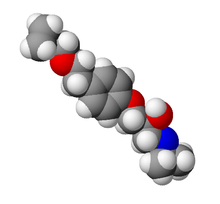Levobetaxolol
 | |
 | |
| Clinical data | |
|---|---|
| AHFS/Drugs.com | Micromedex Detailed Consumer Information |
| Routes of administration | topical (ophthalmic) |
| ATC code |
|
| Pharmacokinetic data | |
| Elimination half-life | 20 hours |
| Identifiers | |
| |
| CAS Number | |
| PubChem CID | |
| IUPHAR/BPS | |
| ChemSpider | |
| UNII | |
| ChEBI | |
| ChEMBL | |
| CompTox Dashboard (EPA) | |
| Chemical and physical data | |
| Formula | C18H29NO3 |
| Molar mass | 307.434 g·mol−1 |
| 3D model (JSmol) | |
| |
| |
| | |
Levobetaxolol is a drug used to lower the pressure in the eye in treating conditions such as glaucoma. It is marketed as a 0.25 or 0.5% ophthalmic solution of levobetaxolol hydrochloride under the trade name Betaxon. Levobetaxolol is a beta-adrenergic receptor inhibitor (beta blocker).
Indications
[edit]It is indicated for intraocular pressure reduction in patients with open-angle glaucoma or ocular hypertension.[1]
Effect
[edit]Levobetaxolol inhibits the beta-1-adrenergic receptor. When applied topically, it reduces intra-ocular pressure (IOP) by 16-23% depending on time of day and the individual. It also has neuroprotective effects.[1] Levobetaxolol has fewer cardiovascular side effects than other beta blockers.
Contraindications and side effects
[edit]Levobetaxolol should not be used by people who have sinus bradycardia, atrioventricular block, cardiogenic shock, or overt cardiac failure. The drug has been associated with bradycardia and hypertension.[citation needed]
History
[edit]Levobetaxolol was developed in the 1980s.[1] It was FDA approved in 2000.[2]
References
[edit]- ^ a b c Quaranta L, Turano R, Pizzolante T (June 2007). "Levobetaxolol hydrochloride: a review of its pharmacology and use in the treatment of chronic open-angle glaucoma and ocular hypertension". Clinical Ophthalmology. 1 (2): 93–7. PMC 2704505. PMID 19668496.
- ^ "Betaxon New FDA Drug Approval | CenterWatch". www.centerwatch.com. Retrieved 11 April 2019.
